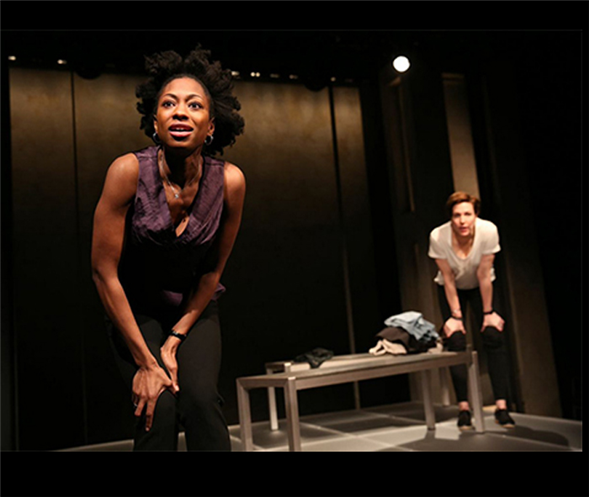Playwright Tanya Barfield may live her life from Event A to Event B to Event C, but she says dream logic ruled when she was conjuring up a 45-year romance for
Bright Half Life, her two-character play now being presented by The Women's Project Theater at City Center Stage II.
"The play was always nonlinear," Barfield says of her 65-minute dramedy, which offers jumbled fragments of a relationship---poetic proposals, blistering breakups, deaths, births, marriage---to tell the story of Vicky (Rachael Holmes) and Erica (Rebecca Henderson), circa 1985-2030.
"I tend to think of the play as prismatic," the playwright continues. "It began as a few pages of disparate, often jarring moments or events between two characters called 'Person One' and 'Another Person' in a document called 'New Idea.' When I was about thirty pages in, I mapped out a loose sequence of how the play unfolds."
More impressionistic and less overtly political than her most recent Off-Broadway play,
The Call, about a white couple preparing to adopt an African baby,
Bright Half Life revels in its broad strokes and narrative jumps. Indeed, "jumps" and "leaps" are ideas that occur throughout: a plane for skydiving, rising elevators, and a precarious gondola atop a Ferris wheel are among its acrophobia-inducing settings.
The challenge of creating an unconventional, ever-shifting shape---indoors one moment, outdoors the next, married one moment, single the next---was to make sure the audience wasn't baffled.
"This structure provides a very active experience for the audience as they constantly have to orient themselves in time and place," Barfield says. "[But] I asked myself: how do I structure a satisfying dramatic arc with a nonlinear narrative? How do I calibrate momentum through a series of short scenes?"
Her longtime collaboration with director Leigh Silverman (
Blue Door, The Call) helped with that.
"Leigh and I discussed which scenes had elliptical shifts and which should feel like jarring jump cuts," Barfield explains, adding that the cutting room floor was littered with "numerous scenes, moments, or fragments that I quite liked. Ultimately, I chose to keep the parts of the play that gave us the greatest sense of story, shape, and momentum."
Barfield found the answer to that structural clarity question in the placement of the play's poetry-spiced monologue in which Erica makes a sudden proposal after appearing at the threshold of Vicky's apartment.
The introduction of this scene is on the first page of the play. It resurfaces to its completion on Page 125, giving the unconventional script narrative tent poles, a sense of "traditional structure, dramatic tension, and rising action," Barfield says. "[It's] chronologically the inciting incident, but it is also the climax. We see the catalyst for the entire play just before the story ends."
You may hear sniffles in the audience during the finale, when Erica says to Vicky, "Take me---you want to go hang-gliding or skydiving or parasailing or wherever. Take me to all those places you want to go…"
{Image2}
With such declarations,
Bright Half Life reveals itself as unabashedly romantic. (The play's title is an astronomical term referencing the light of a collapsing star, but it also suggests that lovers are the shimmering other half of a person's life.)
"For many years, I wanted to write a romantic story," Barfield says. "The dark undercurrents in
Bright Half Life spring from my desire to write about love in all its complexities."
Is there a lot of Tanya Barfield in the characters of Vicky and Erica?
"I would say I'm both Erica and Vicky and neither one of them," she says. "The intimate nature of
Bright Half Life---and the fact that I'm gay and have been married since I was fresh out of college---makes it feel autobiographical. And like many writers, I borrow from my own life at times. But more often, I borrow from my imagination. The craft of making fiction 'real' is the greatest joy of writing."
---
Kenneth Jones is a theatre journalist and dramatist. He also writes at ByKennethJones.com and elsewhere.
Photo by Joan Marcus